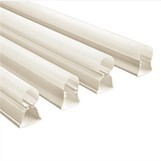As a supplier of extruded lenses, I've often been asked whether extruded lenses can be combined with other optical elements. The answer is a resounding yes, and in this blog post, I'll explore the possibilities, benefits, and applications of such combinations.
Understanding Extruded Lenses
Extruded lenses are manufactured through an extrusion process, which involves forcing a molten plastic material through a die to create a continuous shape. This method allows for the production of lenses with consistent cross - sections over long lengths, making them ideal for various lighting and optical applications. Some common types of extruded lenses include Lampshade PC Diffuser, LED Light Lens, and Extruded Linear Lens.
Extruded lenses offer several advantages. They are cost - effective, especially for large - scale production, as the extrusion process is highly efficient. They also provide good optical properties, such as high light transmission and the ability to control light distribution. Additionally, they are lightweight and can be easily customized in terms of shape, size, and surface finish.
Combinations with Other Optical Elements
Prisms
Prisms are optical elements that can refract, disperse, or reflect light. When combined with extruded lenses, prisms can enhance the light - controlling capabilities of the overall optical system. For example, in a lighting fixture, an extruded lens can be used to collect and direct light from a light source, while a prism can be added to further disperse or shape the light beam. This combination can be used to create unique lighting effects, such as rainbow - like color dispersion or precise light focusing in specific areas.
Mirrors
Mirrors are used to reflect light. By combining an extruded lens with a mirror, it is possible to create a more complex optical path. In some optical instruments, an extruded lens can focus light onto a mirror, which then reflects the light back through the lens or in a different direction. This setup can be used to increase the effective focal length of the system or to redirect light for specific applications, such as in endoscopes or some types of microscopes.


Filters
Filters are used to selectively transmit or block certain wavelengths of light. When an extruded lens is combined with a filter, it can be used to control the color and intensity of the light output. For example, in a stage lighting system, an extruded lens can be used to shape the light beam, and a color filter can be added to change the color of the light. This combination allows for a wide range of lighting effects and can be adjusted according to the specific requirements of the performance.
Fresnel Lenses
Fresnel lenses are thin, lightweight lenses with a series of concentric grooves on one side. They are often used to achieve a large aperture and short focal length. Combining an extruded lens with a Fresnel lens can result in an optical system that combines the advantages of both. The extruded lens can provide initial light collection and basic shaping, while the Fresnel lens can further focus or collimate the light. This combination can be useful in solar energy applications, where efficient light collection and focusing are crucial.
Benefits of Combining Extruded Lenses with Other Optical Elements
Enhanced Optical Performance
The combination of extruded lenses with other optical elements can significantly improve the overall optical performance of a system. By using multiple elements, it is possible to correct for optical aberrations, such as spherical aberration or chromatic aberration. For example, a combination of an extruded lens and a corrective prism can reduce the distortion in an image or improve the quality of a light beam.
Customization
Combining different optical elements allows for a high degree of customization. Depending on the specific application, various combinations can be designed to meet the exact requirements of light distribution, color, and intensity. This is particularly important in industries such as automotive lighting, where different lighting functions (e.g., low - beam, high - beam, and daytime running lights) require different optical characteristics.
Cost - Effectiveness
Although adding additional optical elements may seem to increase the cost, in some cases, it can actually be more cost - effective. For example, using an extruded lens in combination with a simple prism or filter can achieve the same optical performance as a more complex and expensive single - element lens. This way, the overall cost of the optical system can be reduced while still maintaining good performance.
Applications of Combined Optical Systems
Lighting Industry
In the lighting industry, the combination of extruded lenses with other optical elements is widely used. For example, in architectural lighting, a combination of an extruded lens and a prism can be used to create dynamic and energy - efficient lighting solutions. In LED strip lighting, an extruded linear lens can be combined with a filter to provide colored light for decorative purposes. The LED Light Lens can be further enhanced by adding a mirror to increase the light output in a specific direction.
Optical Instruments
Optical instruments, such as cameras, microscopes, and telescopes, can also benefit from the combination of extruded lenses with other optical elements. In a camera, an extruded lens can be part of the objective lens system, and a filter can be added to adjust the color balance or reduce glare. In a microscope, a combination of an extruded lens and a prism can be used to improve the resolution and image quality.
Solar Energy
In solar energy applications, the combination of extruded lenses and Fresnel lenses can be used to concentrate sunlight onto solar cells. The extruded lens can collect sunlight from a large area and direct it towards the Fresnel lens, which then focuses the light onto the solar cell. This increases the amount of sunlight that the solar cell receives, thereby improving the efficiency of the solar energy conversion.
Challenges and Considerations
Alignment
One of the main challenges when combining extruded lenses with other optical elements is alignment. Precise alignment is crucial to ensure that the light path is correct and that the optical performance of the system is optimized. Any misalignment can lead to reduced light transmission, increased aberrations, or uneven light distribution. Specialized alignment tools and techniques may be required during the assembly process.
Compatibility
The optical properties of the different elements need to be compatible. For example, the refractive indices of the extruded lens and the other optical element should be matched to minimize reflection and refraction losses at the interface between the two elements. Additionally, the materials used should be chemically and physically compatible to ensure long - term stability of the optical system.
Thermal Management
In some applications, especially those involving high - intensity light sources, thermal management is an important consideration. The combination of different optical elements may generate heat, and if not properly managed, this can affect the optical properties of the elements. For example, high temperatures can cause the plastic material of the extruded lens to deform, leading to a change in its optical performance.
Conclusion
In conclusion, extruded lenses can be successfully combined with other optical elements to create advanced optical systems with enhanced performance, customization, and cost - effectiveness. The combinations with prisms, mirrors, filters, Fresnel lenses, and other elements open up a wide range of possibilities in various industries, including lighting, optical instruments, and solar energy.
However, when designing such combined optical systems, it is important to consider the challenges of alignment, compatibility, and thermal management. By carefully addressing these issues, it is possible to achieve optimal results.
If you are interested in exploring the potential of extruded lenses and their combinations with other optical elements for your specific application, please feel free to contact us. We have a team of experts who can provide you with detailed information and customized solutions. Our extruded lenses, including Lampshade PC Diffuser, LED Light Lens, and Extruded Linear Lens, are of high quality and can be tailored to meet your exact requirements.
References
- Smith, J. (2018). Optical Elements and Their Applications. Optics Press.
- Jones, A. (2020). The Extrusion Process for Plastic Lenses. Polymer Science Journal.
- Brown, C. (2019). Combining Optical Elements for Improved Performance. Optical Engineering Magazine.




